Dow Jones has been one of the most recognized names in investing. People in the media often talk about “the market” when they actually mean the Dow Jones Industrial Average (DJIA). So what is it exactly? Why should an American investor care? And how can one go about making smarter financial decisions using it?
In this blog, we’ll explore everything you need to know about the Dow Jones — beginning with its historical background, then moving on to how it’s calculated, and finally, delving into the key factors that have consistently helped maintain its relevance in today’s U.S. stock market.
What Is the Dow Jones?
The Dow Jones Industrial Average, often simply called the Dow, is a stock market index that tracks 30 of the biggest and most powerful U. S. companies. These companies are from different sectors of the economy, such as technology, healthcare, finance, consumer goods, and industrials.
Some of the current members of the Dow include:
- Apple
- Microsoft
- Coca-Cola
- Boeing
- McDonald’s
- Goldman Sachs
The Dow gives the investor an idea of how the U. S. stock market in general performs, especially with respect to old and well-established companies.
A Glimpse into the Dow’s History
Created in 1896 by Charles Dow and Edward Jones, the Dow Jones started off with 12 companies, mostly from the industry sector. America, in those days, was fast becoming a great industrial power, and hence the index made sense for that period.
Nowadays, the Dow has 30 companies representing various industries; however, the index retained its “Industrial Average” title as a nod to its past.
Over the years, the Dow has steadily grown to become one of the most reliable indicators of market performance in the United States. Not only has it survived wars, recessions, and financial crises, but it has also continued to evolve — and today, it remains the most-watched index by millions of investors around the globe.
Calculation of the Dow Jones
Unlike the other indexes, the Dow Jones is price-weighted. This means a company with a higher stock price will have more bearing on the index regardless of its market size.
For Example:
- Let Company A be trading at $400 per share and Company B be trading at $100 per share. The price movement of Company A’s share will cause the index to change four times more than what Company B will cause-even if Company B is actually a larger company in revenue or market cap.
- Although this methodology has faced criticism, the Dow does still provide a benchmark of blue-chip U. S. stock performance.
- The Dow Divisor is a very unique number used by the index to maintain its consistency through stock splits and other such changes.
4. Dow Jones vs S&P 500 vs Nasdaq
If you’re new to investing, you’ve probably heard about the S&P 500 and the Nasdaq, too. So how is the Dow different?
| Index | # of Companies | Weighting | Focus Area |
|---|---|---|---|
| Dow Jones | 30 | Price-weighted | Large, stable U.S. firms |
| S&P 500 | 500 | Market cap | Broad U.S. market (large-cap) |
| Nasdaq | ~3,000 | Market cap | Tech-heavy, growth stocks |
In short:
- The Dow is great for tracking long-established companies.
- The S&P 500 offers a broader view of the U.S. economy.
- The Nasdaq often reflects technology and innovation trends.
Why the Dow Still Might Matter in 2025.
The fact that the Dow Jones is over a hundred years old has not changed its phase of utmost relevance in the financial world today, especially in the United States.
Here is why:
- Media Coverage: The Dow is the most profiled index in the U. S. financial media. Those people who are not experts, for the most part,t understand it.
- Psychological Milestones: When the Dow reaches massive levels such as 30,000 or 40,000, these occasions are positioned on national headlines.
- Investor’s Confidence: On occasions when the Dow goes higher, usually, that means a confidence boost for the U. S. economy.
- Historical Context: Investors can look back through the long history of the Dow Jones and contrast the current market with the preceding cycles.
For instance, 2024 saw the Dow hitting 40,000 points for the first time in history-a celebrated moment shared by investors and the media.

How to Track Daily Changes of the Dow Jones
Tracking the Dow is not complicated; in fact, it’s quite straightforward, and more importantly, it can help you gain valuable insight into ongoing market trends.
Where to see real-time Dow data:
- Yahoo Finance
- CNBC
- Google Finance
- MarketWatch
- Your stock trading app (Robinhood, E*TRADE, Fidelity, etc.)
Alternatively, you could turn on free email alerts or push notifications to stay instantly updated whenever there are major movements in the Dow Jones.
Dow-Based Investing Strategies
Of course, the Dow Jones cannot be used to pick stocks, but it can certainly come in handy to determine the direction of the entire market. Here are several ways to incorporate it into your investing:
- Assessing Market Sentiment
If the Dow is well supported and in an upward trend, this represents confidence; however, if it starts to descend precipitously, then that fear or uncertainty could be contagious.
- Use as a Benchmark
For a better perspective, you can compare your portfolio’s performance against the Dow Jones to determine whether you’re slightly underperforming or, on the other hand, outperforming the broader market.
- Buying Dow ETFs
- Buying through exchange-traded funds means buying the Dow itself.
- SPDR Dow Jones Industrial Average ETF, for instance.
In other words, these exchange-traded funds provide you with the opportunity to follow the Dow without the need to actively select individual stocks.
- Monitor Quarterly Earnings.
The majority of the companies of the Dow report earnings quarterly, so pay close attention to their earnings: Big reports earnings from either the likes of Apple or JPMorgan can significantly move the whole index.
Final Thoughts
The Dow Jones is much more than a number on the TV—it is a potent gauge that measures the state of the U. S. economy. Long-term investors and beginners alike can all benefit from a proper grounding in the workings of the Dow.
With a history of over 100 years and a list of incumbent market trends, the Dow will always be the most important mark of reference for Americans in view of the stock market.
By consistently keeping track of the Dow, regularly comparing it with other indexes, and understanding how to incorporate it into your investment strategy, you’ll not only become more financially aware but also take greater control of your financial future.
